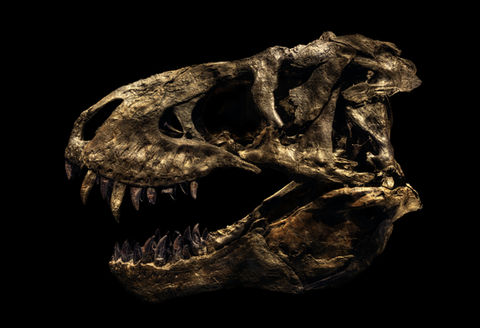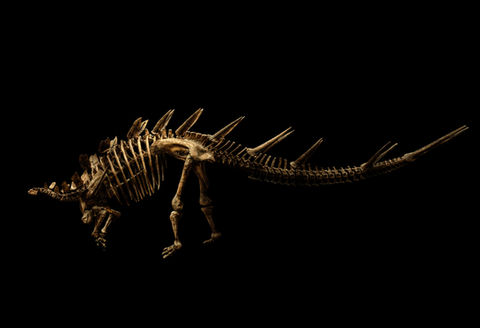EVOLUTION
Someone once wrote that you cannot pass by Christian Voigt’s photographs without stopping for a closer look. All his images capture your eye and your attention. First you are taken aback, then you are drawn in. And you need to step closer to identify the cause. How can a subject you have encountered a thousand times before suddenly seem so fresh and new, as if seen for the first time? And you begin to marvel with childlike amazement at the beauty of the world. This is how first-time viewers of Christian Voigt's work respond to his monumental, hyper-realistic landscape and architectural photography. Initially, the images feel familiar. But there is that sense of puzzlement. And the more the beholder attempts to come to grips with the source of that puzzlement, the further they are transported on a hallucinatory journey into the depth of the surface of things. Now we have Evolution, a series on prehistoric skeletons. Surely we have been here before? T-Rex, the pop star, its jaws agape, towering threateningly on its hind legs? The feathery Archaeopteryx, flying away across a primitive, rocky landscape with its prey in its claws? Brontosaurus, the gigantic herbivore, each of its steps causing the ground to shake? Dinosaurs, the "terrible lizards" (from the ancient Greek deinós for "terrible" or "huge" and sauros for "lizard"), have fascinated us all since childhood. They have formed iconic imprints on our visual memory, in the same way as the Red Cross, the Union Jack and the Coca-Cola logo. We have seen them a thousand times, read about them in children's books, collected them as figurines, adored them as cartoon characters, learnt about them in biology class, visited them in natural history museums, and quaked in our cinema seats as they appeared as Hollywood-style monsters in Jurassic World. Christian Voigt has again ventured into photographic territory that has been measured, mapped, studied and trivialized to the nth degree. And despite, or because, of this fact he again instantaneously succeeds in casting an enigmatic spell over us. At first glance, the figures depicted in his monumental, large-format, deep-black photographs appear to be drawn from fantasy fiction—something from Tolkien’s world, but suddenly reality. They are three-dimensional, huge, almost alive. At second glance, however, we detect something strangely familiar. Our body releases an extra rush of adrenalin. But our brain activates its critical faculties. Human intelligence begins to analyze these strange photographs. Is this authentic? Why this color? Is this genuine? If so, why does it look so hyper-real? They have an almost physical impact on us—precisely because there is no addition, intention, or guile. They simply are. This is how Christian Voigt works. Born in Munich, and with homes in Hamburg and the south of France, Christian Voigt is a restless traveler, always in search of the "city beyond the hills." Travel is his life's purpose, encounters are his life’s elixir, the search for beauty his life’s motif—underpinned by all-pervasive perfectionism. These are the keys to his unfathomably sumptuous images of landscapes and architecture, his unmistakable photographic technique, and visual language—that have catapulted him to rapidly growing, international fame, and made his works sought-after acquisitions in an increasing number of private collections. For Christian Voigt the artist, it would probably make sense to leave his unique visual language unaltered, and to simply collect new images on new travels to new locations. But for Christian Voigt the traveler, that it is not an option. It would feel as if he had come to the end of the road. "To me, the purpose of travel is the journey itself, not reaching a certain location. As a traveler, as a human being, and as a photographer, I don't want to be at a point where I say: I've reached my destination. This is where I am going to stay.” With Evolution, Christian Voigt has radically expanded both his visual vocabulary and his portfolio of photographic techniques. These are not carefully sought-and-found subjects, as is the case with Voigt’s landscape and architectural panoramas. Instead, he presents us with objects as they are—captured under almost laboratory-like conditions. This is not a heightened depiction of reality, but the systematic staging of it, even to the extent of eliminating the surroundings in favor of black non-light. Christian Voigt wants his Evolution series to be regarded more as objects than as images. Voigt the perfectionist does all he can to achieve his intended effect: from the choice of large-format paper, to the highly detailed instructions on the lighting, to the specially conceived frames—these are integral parts of the photographs, and were redesigned several times in their making. "The idea for Evolution came to me in 2017 when I was photographing the huge blue whale skeleton suspended from the ceiling of the Hintze Hall in the Natural History Museum in London. For me, there was an odd tension between the archaic power of this huge skeleton and the strict order of the surrounding architecture," explains Christian Voigt. "I continued to pursue this tension—and arrived at this radical depiction against a black backdrop. Usually, I want my pictures to convey how I see something. But with the dinosaurs, I want to show the impact they have on me. And to do that, I had to find new methods." What remains is an X-ray-like view of the surface of things that is so detailed it feels like a hallucination. Much like his landscape photographs, Christian Voigt's Evolution images push the limits of today's photographic techniques and technology. They are the result of meticulously planned, extremely time-consuming multiple exposures taken with large-format analogue cameras. These images are subsequently layered on top of each other, exposed again and printed on paper to create a single picture. It is a process that often takes weeks. Without adding anything extra to the image itself, each individual bone and each individual detail is modeled one by one, and staged to perfection. As a result, Christian Voigt's Evolution photographs are supernaturally clear depictions, with hyper-ideal lighting and uncannily crisp contours. The result is more real than reality. But their puzzling mystery remains.






















